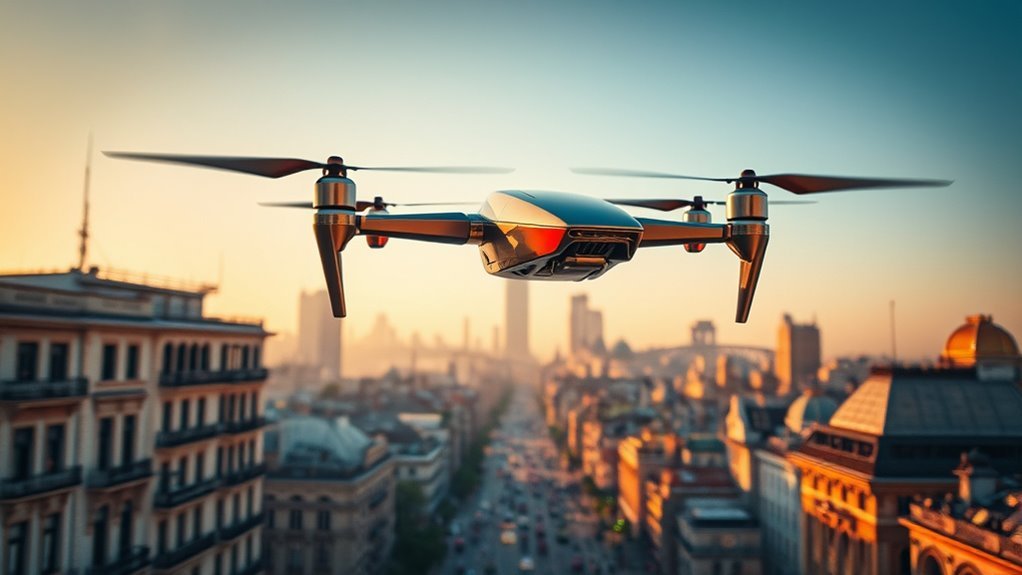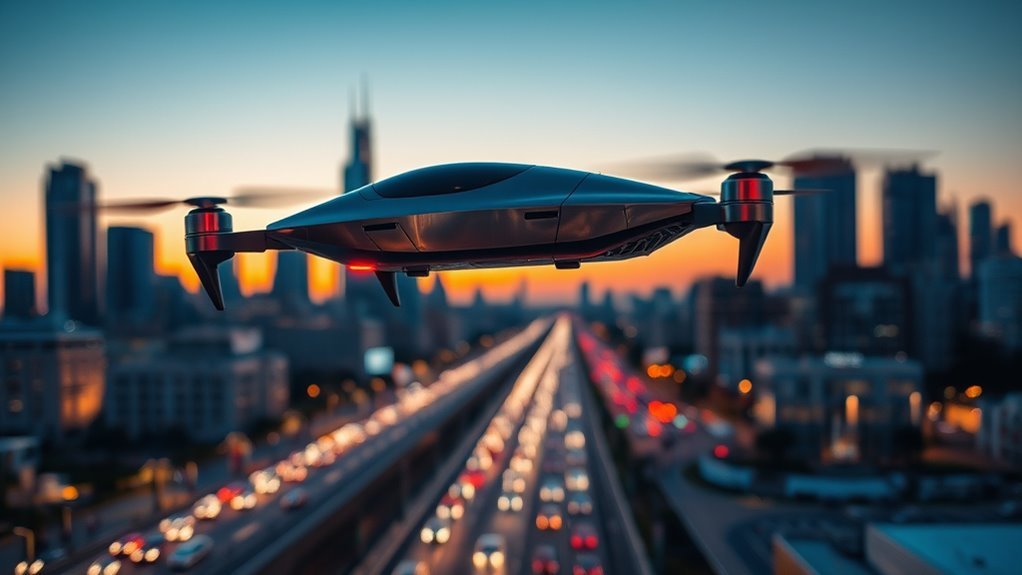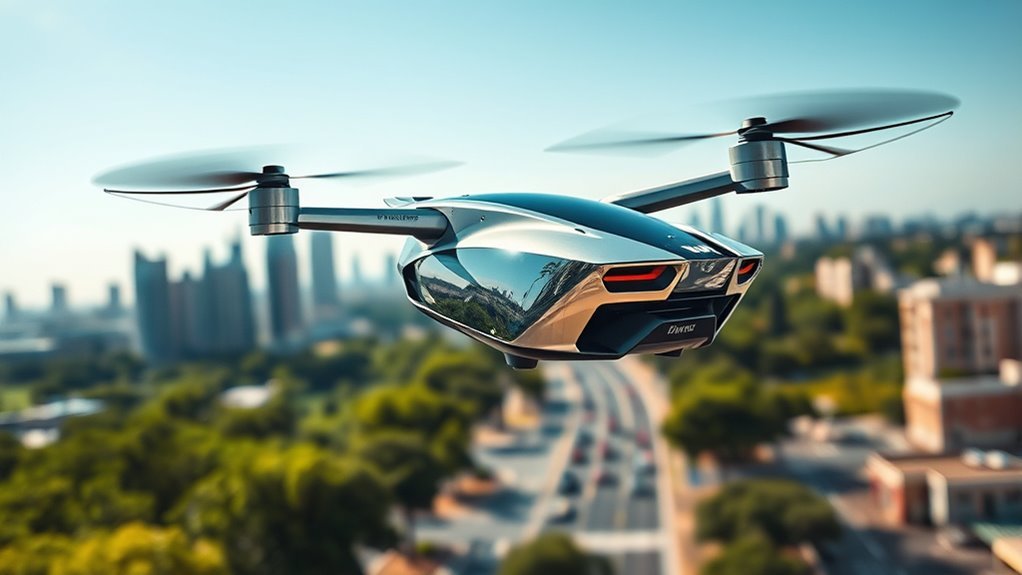A car drone is a groundbreaking fusion of automotive and aerial technology, allowing vehicles to seamlessly shift between driving and flying. With advanced navigation systems and obstacle detection, these vehicles are designed for efficiency and sustainability in urban transport and logistics. They offer potential for quick deliveries, emergency responses, and traffic monitoring. However, challenges like safety regulations and public acceptance remain. Stay tuned to explore more about their capabilities and future applications.
Definition of Car Drones

Car drones are an innovative fusion of automotive and drone technology, designed to enhance transportation and logistics. These vehicles combine the mobility of cars with the aerial capabilities of drones, offering unique solutions for urban travel and delivery services. With car drone technology, you can navigate congested city streets and soar above traffic, creating a new domain of freedom in transportation.
The benefits of car drones are numerous; they can reduce travel times, lower emissions, and optimize delivery routes, making them an eco-friendly choice. Imagine a world where you can bypass gridlock and reach your destination swiftly. By embracing this cutting-edge technology, you’re not just improving your commute—you’re also participating in a revolutionary shift towards smarter, more efficient transportation solutions.
The Technology Behind Car Drones

When you think about car drones, it’s vital to understand the technology that powers them. These vehicles rely on advanced autonomous navigation systems for safe operation, while their aerial imaging capabilities enhance situational awareness. Additionally, robust communication and control links guarantee seamless interaction between the drone and its operator, making them a fascinating fusion of mobility and innovation.
Autonomous Navigation Systems
As technology continues to evolve, autonomous navigation systems have become a critical component of car drones, enabling them to operate safely and efficiently. These systems rely on advanced sensor integration and sophisticated mapping algorithms to navigate complex environments with ease. Here are three key aspects that enhance their functionality:
- Real-Time Data Processing: They analyze data from multiple sensors, ensuring the drone responds quickly to dynamic surroundings.
- Obstacle Detection: Utilizing LIDAR and cameras, they identify obstacles, preventing collisions and enhancing safety.
- Route Optimization: By employing mapping algorithms, they calculate the most efficient routes, maximizing travel time and efficiency.
With these technologies, autonomy in car drones isn’t just a dream; it’s a reality, giving you the freedom to explore without limits.
Aerial Imaging Capabilities
Although many people associate drones with aerial photography, car drones have taken this technology to new heights, offering unique aerial imaging capabilities that enhance their functionality. With advanced imaging technology, these vehicles provide stunning overhead views, capturing everything from scenic landscapes to detailed urban environments. Imagine the freedom of exploring terrains while simultaneously documenting your journey from above. Car drones are equipped with high-resolution cameras that guarantee crisp imagery, making them invaluable for various applications, including real estate, event coverage, and even environmental monitoring. By integrating aerial photography seamlessly into their operations, car drones not only expand your visual perspective but also redefine how you interact with the world around you. The possibilities are as limitless as your imagination.
Communication and Control Links
The impressive aerial imaging capabilities of car drones are powered by sophisticated communication and control links that guarantee seamless operation. These links facilitate high signal integrity and efficient data transmission, allowing you to enjoy real-time visuals without interruptions. Here are three key components that make this technology work:
- Radio Frequencies: Car drones use specific frequencies to maintain strong communication links, reducing interference from other devices.
- Protocols: Advanced protocols help manage data flow and ensure that commands from the ground reach the drone promptly.
- Telemetry Systems: These systems monitor the drone’s status, providing feedback on battery levels, altitude, and more, assuring you have complete control.
With these technologies, your driving experience becomes smoother, more connected, and ultimately, more liberating.
Key Features of Car Drones

When exploring the key features of car drones, you’ll find that their innovative design and advanced technology set them apart from traditional vehicles. One standout feature is the ability to seamlessly shift between driving and flying, enhancing mobility and freedom. These design innovations cater to modern market trends, emphasizing efficiency and versatility. Car drones are equipped with smart navigation systems, allowing for autonomous travel and real-time obstacle detection, ensuring safety. The integration of eco-friendly power sources is another notable aspect, reflecting a commitment to sustainability. Additionally, customizable interfaces provide users with personalized control, enhancing the driving experience. Ultimately, car drones represent a revolutionary leap in automotive technology, poised to redefine how you perceive transportation.
Potential Applications of Car Drones
As you consider the potential applications of car drones, it’s clear they could revolutionize various sectors beyond personal transportation. Their versatility allows for innovative solutions in multiple fields:
- Delivery Services: Imagine car drones efficiently transporting packages, reducing delivery times and traffic congestion, much like the delivery reliability seen in drone technology such as the Amazon MK30 and Brinc Responder.
- Traffic Monitoring: They can provide real-time data on traffic patterns, helping urban planners manage congestion and improve infrastructure.
- Emergency Response: In critical situations, car drones can quickly reach areas inaccessible by traditional vehicles, delivering medical supplies or assisting in search-and-rescue operations.
Furthermore, AI-enhanced flight capabilities ensure that car drones can navigate complex environments effectively, adapting to obstacles and changing conditions in real-time.
From agricultural surveying to surveillance operations, car drones present exciting possibilities. They blend technology with creativity, offering freedom and efficiency for urban planning and recreational use. The future of car drones could be as dynamic as your imagination allows.
Benefits of Using Car Drones
Car drones offer numerous benefits that extend beyond their innovative applications. You’ll find that they provide significant cost savings, especially in delivery services where efficiency is key. Imagine receiving your package faster and at a lower price! They also enhance time efficiency, cutting down travel times in urban environments, allowing you to reclaim precious hours. With their minimal environmental impact, car drones contribute to greener cities. They excel in traffic management, reducing congestion, while also serving essential roles in surveillance applications and emergency response. By integrating these drones into urban planning, cities can become smarter and more responsive to citizen needs. Overall, embracing car drones is about releasing freedom and harnessing technology for a more efficient future.
Challenges and Limitations
As exciting as car drones are, you’ll need to contemplate the challenges and limitations that come with them. Regulatory hurdles can slow down progress, while technical limitations might affect their performance on the road. Plus, safety concerns remain a top priority, making it vital to address these issues before widespread adoption can occur.
Regulatory Hurdles Ahead
While the potential for car drones to revolutionize transportation is exciting, significant regulatory hurdles loom on the horizon. You’ll need to navigate a complex landscape shaped by government policies and legal frameworks. Here are three key challenges you might face:
- Safety Regulations: Ensuring car drones meet safety standards can slow down innovation and deployment.
- Airspace Management: Coordinating with existing air traffic control systems presents a challenging task that requires careful planning.
- Liability Issues: Determining responsibility in the event of accidents will complicate legal frameworks, impacting consumer trust.
As car drones inch closer to reality, overcoming these hurdles is essential for realizing their full potential and giving you the freedom to embrace a new era of transportation.
Technical Limitations Present
Maneuvering regulatory hurdles isn’t the only challenge facing the development of car drones; technical limitations also pose significant obstacles. You’ll find that several factors impact their viability in everyday use.
| Limitation | Description | Impact |
|---|---|---|
| Battery Capacity | Limited energy storage | Affects flight duration |
| Payload Limitations | Maximum weight restrictions | Limits transport ability |
| Sensor Accuracy | Precision of navigation sensors | Influences collision avoidance |
| Weather Dependence | Vulnerability to environmental conditions | Affects reliability |
| Software Reliability | Stability of operating systems | Risks signal interference |
These challenges must be overcome to release the true potential of car drones, allowing for greater freedom in transportation.
Safety Concerns Persist
Although the promise of car drones excites many, safety concerns persist that could hinder their widespread adoption. First, perception issues arise when drones share the road with traditional vehicles, potentially leading to accidents. Next, privacy concerns are paramount; people fear being monitored by drones, infringing on their personal space and autonomy. Finally, regulatory challenges complicate the integration of car drones into existing transportation systems, making it difficult to establish clear guidelines.
Addressing these issues is vital for public acceptance. As you consider the future of car drones, it is important to weigh the benefits against these significant safety hurdles. Only by tackling these challenges can we truly embrace the freedom and innovation these technologies promise.
Regulatory Considerations
As the technology behind car drones takes off, regulatory considerations are becoming increasingly critical. Maneuvering through the legal frameworks surrounding these innovative vehicles can be intimidating, especially with the compliance challenges they present. You’ll need to stay informed about local laws and regulations to fully enjoy the freedom car drones can offer.
| Aspect | Considerations |
|---|---|
| Legal Frameworks | Vary by region; stay updated! |
| Safety Regulations | Must comply with aviation standards. |
| Privacy Issues | Data collection must be managed. |
| Insurance Requirements | Coverage can differ greatly. |
Understanding these factors not only enhances your experience but also guarantees you remain on the right side of the law.
Future Trends in Car Drone Development
With advancements in technology accelerating at an unprecedented pace, the future of car drones looks promising and multifaceted. You can expect significant shifts that will enhance urban mobility and redefine how goods are delivered. Here are three trends to watch:
- Integration with Smart Cities: Car drones will connect with urban infrastructure, optimizing traffic flow and reducing congestion.
- Aerial Delivery Services: Imagine receiving packages from the sky, as businesses adopt drones for efficient last-mile deliveries.
- Enhanced Safety Features: Innovations like collision avoidance systems will make car drones safer for you and others on the road.
As these trends unfold, you’ll find that car drones will not only offer convenience but also greater freedom in how you navigate your urban environment. Additionally, advancements in AI-driven autonomous navigation will ensure safer operation and enhanced integration with existing urban systems.
Real-World Examples of Car Drones
The promising trends in car drone development are already manifesting in real-world applications, showcasing the potential of this technology. Companies like Tesla are exploring innovative designs that integrate drone capabilities for autonomous deliveries, enhancing convenience and efficiency. Imagine a scenario where a drone launches from your car, delivering packages directly to your doorstep while you continue your journey. Similarly, startups are developing aerial vehicles that combine driving and flying, aiming for seamless urban mobility. These applications not only redefine transportation but also offer a taste of freedom, allowing you to navigate through traffic or access remote areas effortlessly. As these innovative designs evolve, they bring us closer to a future where car drones revolutionize our everyday travel experiences.
Frequently Asked Questions
How Much Do Car Drones Typically Cost?
When exploring car drone pricing, you’ll find costs typically range from a few hundred to several thousand dollars. Doing a cost comparison can help you determine which model fits your budget and needs best.
Can Car Drones Be Used in Bad Weather?
Sure, you could use a car drone in bad weather, if you enjoy the thrill of watching your investment plummet. Drone capabilities often falter in adverse weather conditions, turning your ride into a risky adventure.
Are Car Drones Safe for Pedestrians?
When considering pedestrian safety, car drones must adhere to strict drone regulations. You should be aware that technology’s evolution might improve safety features, but potential risks remain. Always stay informed and cautious around these innovations.
How Long Does a Car Drone Battery Last?
A car drone’s battery lifespan typically ranges from 30 minutes to several hours, depending on its power efficiency. Understanding these factors can help you choose a model that aligns with your adventurous spirit and freedom needs.
What Brands Manufacture Car Drones?
When exploring car drone brands, you’ll find popular models from established companies like DJI and Parrot. These brands continuously innovate, offering features that enhance your driving experience and freedom to explore the skies above.

